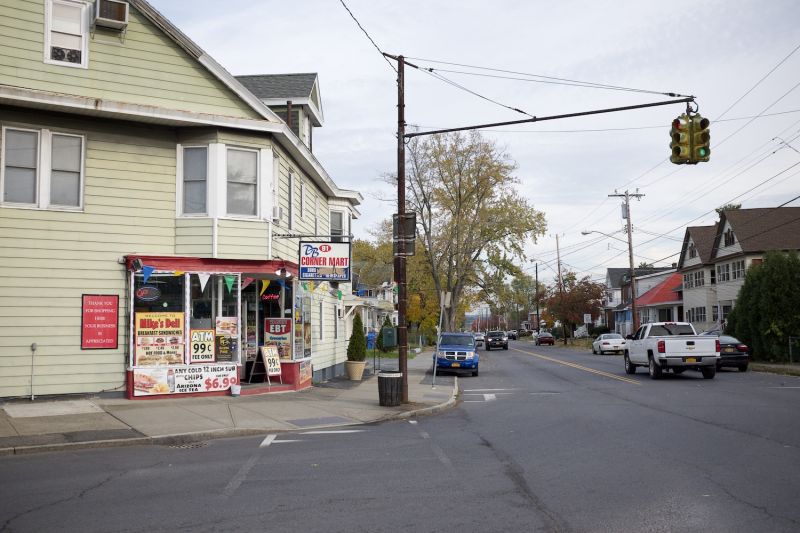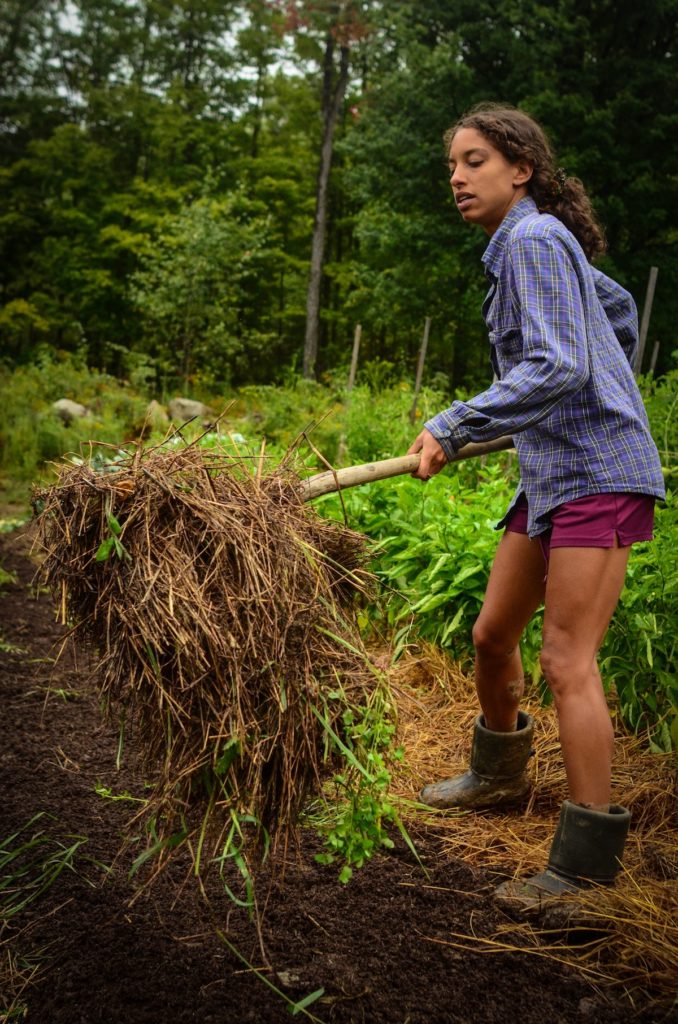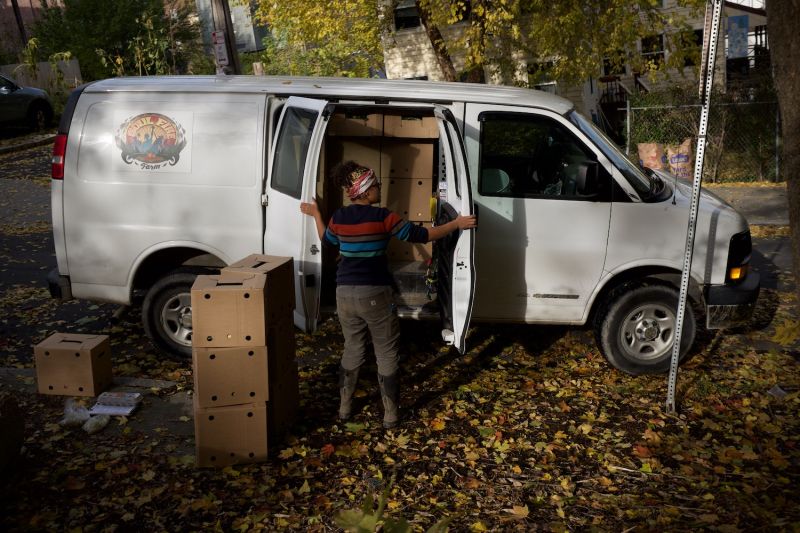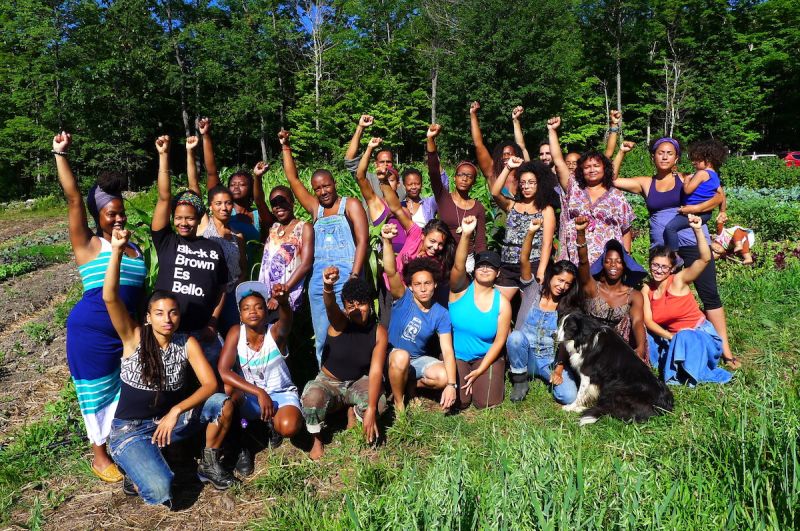Americans of color are largely excluded from producing and eating fresh food
Syndicated from The Counter
11.08.2018
A conversation with Leah Penniman, author of the new book Farming While Black.
Near the end of a five-hour delivery run, Lytisha Wyatt rings an apartment in Albany, New York’s South End. A little girl answers the door, furtively accepting the box of organic produce. It’s one of 97 being delivered throughout the area, and the last of the season, courtesy of Soul Fire Farm’s Community Supported Agriculture (CSA) program. As Wyatt walks away, the girl’s mother leans out the second floor window. “Thank you so much! Thank you for everything! Is this the last week? Thank you!”
Every week during harvest season, Soul Fire delivers sustainably grown vegetables, eggs, chicken, and other produce to about 100 families, or roughly 300 people in Albany, Troy, and Grafton. The boxes are priced on a sliding scale based on what recipients can afford. Some receive them for free, ‘solidarity shares’ subsidized by those who can pay more. This week, the box contains winter squash, two onions, five pounds of potatoes, daikon radishes, cabbage, turnips, carrots, salad mix, collard greens, broccoli leaves, kale, green tomatoes, parsley, and popcorn.
Food like this isn’t easy to come by in Albany’s South End, a federally recognized “food desert.” The term has come under criticism in recent years for failing to convey the fact that food insecurity is a man-made phenomenon, often the result of discriminatory policy. Food insecurity affects black communities at a rate of more than 26 percent, and over 22 percent for Latinx folks, compared to a national average of 15 percent. The South End is more than 70 percent African-American, and it’s where most of Soul Fire’s food gets delivered.
Despite the rich production of the region’s foodshed, more than 40,000 people in Albany County live under what those in the food justice movement increasingly refer to as “food apartheid”—deserts, after all, are a natural phenomenon.
“Food really can be medicine, or it can be a weapon that prevents civic participation,” says Leah Penniman, co-founder, co-director and program manager of Soul Fire Farm. “If you’ve only got a few dollars in your pocket, and there’s just a bodega or a package store, you can get Hot Cheetos and blue drink. That really undermines your health, your ability to learn in school, your ability to parent, to be a citizen. And it’s intentional.”

Don’t call it a “food desert”—call it “food apartheid.” Deserts, after all, are a natural phenomenon, Photo Doug Bierend
Through Soul Fire, Penniman has become a leader in the movement to reverse the effects of historical, systematic exclusion of black and brown communities from the means of production and consumption of wholesome food, and to reconnect those communities with a long, oft-forgotten history of land stewardship. Her new book, Farming While Black, available now from Chelsea Green Publishing, is a how-to for historically disenfranchised communities to establish sustainable, equitable, profitable, and dignified relationships with the food they eat, and the land it comes from.
Penniman and her family used to live in the South End area, prior to buying the 72-acre plot in nearby Grafton, where Soul Fire now operates a five-acre organic, no-till farm. “We didn’t have access to good food, which is part of what catalyzed us to create Soul Fire,” Penniman says. “We thought, if it’s this hard for us to get vegetables, with a master’s degree and years of farming experience, how much more difficult is it for our neighbors, and what can we do about that?”
Addressing food apartheid is not merely a matter of overcoming a lack of supermarkets. So in addition to its efforts to provide access to healthy food, Soul Fire operates immersion training programs for black, Latinx, and indigenous farmers. The goal is to enable a new generation of farmers to connect with and revive a largely forgotten cultural legacy of food sovereignty. All author proceeds from the book will go to fund scholarships for these training sessions.
“Even if there was a grocery store, that’s not a replacement for education on where the food comes from, or an appreciation of how long it takes, or an appreciation of your culture, of what foods mean to your background,” says Mia Nilo, Frederick Douglass Fellow and executive administrator at Albany’s Center for Law and Justice—she and the center also receive food boxes from Soul Fire’s CSA.
 Soul Farm's Leah Penniman, photo Jonah Vitale-Wolff
Soul Farm's Leah Penniman, photo Jonah Vitale-Wolff
By the 1920s, there were some 925,000 black-owned/operated farms in the U.S., or roughly 14 percent of all farms in the country. Now, according to the United States Department of Agriculture (USDA), less than one percent of farm owners, and only about two percent of farmers, says the Bureau of Labor Statistics (BLS), are black.
Numerous factors fed into this shift, including discriminatory lending by USDA, the Great Migration of some six million African-Americans from the rural south into northern cities, and mass industrialization that drew black workers into factories. The result is that farming in the U.S.—at least in terms of who owns and profits from it —is essentially a white enterprise. Even the movements to address these disparities have been predominantly white.
Farming While Black maps out how to find, buy, and make productive, sustainable use of land in accordance with traditions and in a manner that prioritizes healing and dignity. So the book focuses not just on techniques for building raised beds and terraces, practicing crop rotation, preserving food; and other standard practices of establishing and running a sustainable, profitable farm. It also taps into the roots these practices have in black, Latinx, and indigenous traditions that, though not often discussed, are fundamental to the history of farming in America.
Penniman’s book reviews traditional methods of financing—such as the Caribbean susu—organizational approaches, movement building, and forming interracial alliances to undermine systemic racism at the community level. Punctuating the instructional chapters are ‘Uplift’ breakout boxes that unpack the history of black involvement in food justice—and its future. Quotes from activists and writers like Malcolm X, Fannie Lou Hamer, Ta-Nehisi Coates, even King T’Challa (aka the fictional super hero Black Panther) appear throughout, underlining a sense of deep tradition and relationship to land, and a connection to power through that relationship.
The New Food Economy spoke with Penniman about Farming While Black, and the work of Soul Fire Farm, on the day of its last CSA run for 2018. The interview has been edited for length and clarity.
TNFE: Is Farming While Black a book you wish you’d been able to read when you started out?
Penniman: Toni Morrison says if there’s a book you need to read, go and write it. So that’s very much where this came from. I started farming when I was 16, and aside from The Food Project, which was my first farming job, it was a pretty white-dominated space. All the conferences and books and everything that I encountered were written by, provided by mostly white men, and so there was a lot of questioning that I had as a young person about whether I belonged in the farming movement, and whether I was being a traitor to my people.
Little did I know at the time, but I found out through my work here at Soul Fire, and through writing this book, that of course, black, indigenous, other people of color had a really deep, enduring history in terms of contributing to sustainable agriculture—coming up with new technologies, and innovations in marketing. It’s just not told. It’s an ignored history. So this book, in part, is designed for that next generation, that returning generation of farmers who are black and brown, who are saying, ‘I want to get into this, but do I belong?’ And the answer, of course, is, ‘Yes, and here’s all these examples of how you belong.’”
TNFE: There is plenty to reinforce the impression for a person of color that farming, or even food justice, are not meant for them.
Penniman: We often get told the myth that our only relationship to land and agriculture is that of oppression, of enslavement, and sharecropping and tenant farming, which is certainly a bleak stain and an original sin of this nation is that history. But that’s a few hundred years out of the tens of thousands of years of a dignified and autonomous connection to land. Part of the work of Farming While Black is to reach back beyond that more recent history to a more enduring history and root ourselves there, as we talk about returning to land in a new way. The land was the scene of the crime, the land itself is not the crime. Finding ways to connect with our land in a way that would make our ancestors proud is what that’s about.
TNFE: Apparently even the CSA model itself traces its roots to an African tradition?
Penniman: Many similar models emerged from many cultures. There’s a Japanese version, so it would be dangerous and problematic to claim that black people thought of everything. But Booker T. Whatley out of the Tuskegee Institute in Alabama did come up with what he called a ‘clientele membership club’, which is essentially a CSA. Urban folks buy a membership, and then they get wholesale prices for their food throughout the season. He also came up with one of the first pick-your-own operations. People thought he was nuts at the time, because it’s like, yeah, people come to your farm and harvest, and then they’re going to pay you for the privilege to harvest? People just thought he was nuts. But of course, how many of us go apple picking or cherry picking now? I know I certainly do.
 Lytisha Wyatt, a Soul Fire Farm employee, unloads the CSA delivery van, Photo Doug Bierend
Lytisha Wyatt, a Soul Fire Farm employee, unloads the CSA delivery van, Photo Doug Bierend
Whatley was really responding to the fact that black farmers were being excluded from a lot of the commodity crop-type markets. They couldn’t make money on cotton or tobacco, so he was thinking of new ways to diversify horticulture so that black people could get a market share. He was really innovative and ahead of his time.
TNFE: How does someone who is running a farm also manage to do deep research into this kind of hidden history?
Penniman: I had a hypothesis really, from the moment I met Karen Washington at the Northeast Organic Farmer’s Association Conference, and she said, ‘We have a place here. We belong here.’ I developed a hypothesis that all these sustainable techniques that get branded as permaculture or agroforestry, and are assumed to be ahistorically European, have roots in black, indigenous, and other people of color. And it just took a little bit of looking. The information doesn’t exist all in one place anywhere.
I would give a shout-out to the book Black Rice and to Dr. Monica White, for doing some research on cooperative. There are a few scholars out there, but for the most part it was a lot of original research, of being like, ‘I have a feeling that raised beds came from somewhere. Oh look, the Ovambo people in Namibia.’ Or, ‘I have a feeling that this idea of agroforestry and intercropping came from somewhere. Oh yeah, there were 28 systems in Nigeria like this.’
With the help of a research assistant named Juliette Tarantino, over the last year, we started compiling an annotated bibliography of black agrarianism, which informs all those ‘uplift’ sections in the book that talk about the history. And sure enough, pretty much every practice that we engage in in the sustainable farming movement has roots on the mother continent.
TNFE: What is the demand for Soul Fire’s work, and what have you seen in terms of impact?
Penniman: It’s been really profound beyond belief. When we started Soul Fire, we were like, ‘Oh, we’ll just feed the community,’ like any farmer would think about. And pretty quickly after we got off the ground there were people reaching out to us from all across the region—and the nation—saying, ‘We want to learn to farm in a culturally respectful and responsive environment that’s going to support us and help us heal from the trauma of land-based oppression, and teach us our history as well as these farming skills.’
We’ve had 500-plus people come through the Black Latinx Farmers Immersion, which is our flagship program. It’s our 50-hour beginner farmer training. But then, thousands more come through for one-day workshops and other types of events. I would say that the impact has been way beyond anything I could imagine, and it’s a deep, deep honor to get to steward this work. People say things like, ‘This is what it looks, tastes, sounds like to be free; I’m not going to settle anymore for being anything less than my full self; I’m remembering things I didn’t know I forgot.’ There’s a big psycho-spiritual component to being immersed in an environment that is really centering black/indigenous ways of farming and being with each other and being with the land.
 Attendees of Soul Fire Farm’s Black Latinx Farmers Immersion, Photo Soul Fire Farm
Attendees of Soul Fire Farm’s Black Latinx Farmers Immersion, Photo Soul Fire Farm
There are metrics that matter to the material world, and matter to us too: 85 percent of our graduates continue with farming and food justice leadership. We have a number of new farms that have come up from our graduates, including High Hog Farm outside of Atlanta, Georgia; Catatumbo Farm outside of Chicago, Illinois; Wildseed Community Farm in Millerton, New York. There are a number of amazing projects that have been started by our graduates, but I think even more importantly, or as important, is this really profound healing, this sense that we do have a right to belong to the earth and have agency in the food system, and we can claim that right in this generation.”
TNFE: The goal of this work seems to be planting seeds in that fashion, rather than trying to scale up your own operation.
Penniman: We think about scaling out rather than scaling up—the way that mycelium work in the forest. Science has shown what we’ve all assumed, that the forest is a superorganism, and that trees communicate with each other. They share sugars, and they share minerals all through an internet of mycelium hyphae of fungus. That’s the metaphor for the way we want to think about growing. We’re a hub tree, we’re a mother tree, and we’re sending out these resources and sharing them not just with our own children, but also with other species; they in turn, are using them and sharing them out.
We are not excited about the idea of having a staff of 50 and 100 million acres, that’s not really what we’re interested in. What we’re interested in is finding ways to support, and feed, and grow these sibling projects that come out of the work of our alumni. And all of these will be unique. Soul Fire works really well for our particular community, the nexus of needs, but High Hog farms is working with Southern black livestock farmers who want to transition to organic. That’s not what we have up here. Catatumbo Farm is working with people who are undocumented, and it’s using a worker/owner co-op model, because you can own a business but you can’t be a wage earner in the U.S. if you don’t have documents. So that’s a homegrown solution for their community. We want there to be 1,000 farms like Soul Fire, not replicants of Soul Fire.
TNFE: That seems to be a radical model, insofar as it’s more interested in circulating value than in extracting it.
Penniman: Exactly, or just the capitalist idea. If I were to tell you that year one, we had 25 CSA members, and then year two, 50, and then 100, and then 75, you would think, ‘What happened? What went wrong?’ But to us that might be a success story. That might be because we found our K value, we found our limit, and so we needed to pull back to something sustainable so that we could be healthy as individuals—as a farm team—or so we could put energy toward something else and not just bigger, bigger, bigger all the time. We have to educate funders about that too, because they’re like, ‘When are you going to double, triple, quadruple?’ And we’re like, ‘Never.’ We are always going to fit around this table, so we can actually talk to each other.”
TNFE: In the early 20th century, around 14 percent of American farms were black-owned. Now, just over one percent of farm owners, and only about two percent of farmers, are black. What is it like to establish a farm as people of color, in such a white context?
Penniman: The USDA classifies farmers as owner/operators or managers—the first or second manager—so it obscures the truth that over 85 percent of the people who grow our food are brown people, are Latinx people, Spanish-speaking, many of whom were not born in this country. That’s something we have to really sit with and think about in terms of how we value people and who we consider a farmer.
That decline from 14 percent in 1910 is really because of a legacy of USDA discrimination and exclusion, of targeted racist violence against black farmers by the KKK in the South, their property loss, all this well-documented discrimination. But we’re very fortunate that we don’t feel isolated because so many people are coming through.
Neighbor relationships take a lot of intentional work to keep our community safe, and we’re very grateful that we’ve been able to form positive relationships with most of our neighbors. We try to be very generous, to do more than our fair share of the driveway maintenance for the shared driveway, make sure that our sign isn’t blocking the veteran’s flag, buy eggs from neighbors, and hire them to do excavation work. When we bought the land in 2010, we delivered a lot of cookies to the neighbors, literally and metaphorically. People are people and most of them are nice. But we don’t talk politics.
Black folks have to think about these relationships a lot, because not everyone is as lucky. I definitely hear from our alumni and folks in my network, ‘People are killing my pigs, they’re diluting my fertilizer, they’re just harassing us, leaving trash in our lawn,’ just all these aggressive ways folks can make you feel like you’re not welcome. Or let you know that you are not welcome, it’s not just a feeling.
TNFE: How did you settle on this land as the location for Soul Fire Farm?
Penniman: When we were looking for different properties, there were no other places that gave us the feeling of being ‘claimed’ by the land, and we confirmed that using the spiritual tools that we have. For instance, we asked, ‘Does this land want to be used for this purpose? Does this land consent?’ It’s really important to us.
Practically speaking, we’re 25 minutes from Troy, 40 minutes from Albany, so the market that we wanted to serve, which is predominantly low-income people of color, is not far away. Grafton is a town known to folks in Albany and Troy because of Grafton State Park and the Peace Pagoda, so at least it doesn’t sound scary.
TNFE: Is it a tricky line to walk, as a farmer and a teacher, between the practical and spiritual aspects of growing food and building community in accordance with your cultural traditions?
Penniman: It’s felt pretty natural, honestly. I don’t have a lot of patience for theory without practice, or armchair activism, or just tweeting about what you’re annoyed about. I really believe that we need to be the change we wish to see in a very tangible, physical sense. So the foundation of this farm is a farm. It’s not the idea of a farm. Day in, day out, it’s cold fingers, delivering food—all the things that go into it. The book and the work really need to be centered on the practical: How do you save a seed? How do you have a business meeting? How do you run a youth program?
But dealing with this work as if it were material, and not also alive, not also its own sort of living, breathing entity, would be disingenuous too, because that’s not part of our cosmology. The storytelling about Soul Fire and the weaving in of reverence for land and the spiritual components and the history, really speak to the heart. For us, Soul Fire is both: the soul being that spiritual component, the fire being the passion and the energy to do.
TNFE: Are you hopeful about the prospects of this work to create a viable way to build power, equity, dignity, and food sovereignty for communities of color in America?
Penniman: In many ways we are already winning. It would be inconceivable when I started farming back in the 90s for there to be a conference that 500 or 800 people would attend that was all black farmers, urban and rural working together, North and South. And now that happens every year.
The last USDA Census showed, for the first time, an uptick in the number of black farmers since the early 1900s. It was a small uptick, but it bottomed out, and I think we’re headed back up. Obviously, there are deep policy changes that need to happen. Right now, farmers don’t have the same legal protections as other workers. Still, USDA disproportionately gives its money to other farms that are growing commodity crops, and not to small farms and not to farmers of color. The Supplemental Nutrition Assistance Program (SNAP) is being gutted.
But as far as what’s happening on the grassroots side, I’m very encouraged and very hopeful. We’re making a fundamental change in the way we think about our relationship to land that is long-view. It’s really long-view: We’re part of a 10,000-year-old history. It’s not something we’re going to change in four years but we’re on the right track. It’s not, “What’s our quarterly return?” It’s “What’s this return for our children?”
Syndicated from The Counter, a nonprofit, independent, nonpartisan newsroom investigating the forces shaping how and what America eats. Doug Bierend is a freelance journalist writing about science, technology, media, education, food, and the various ways they point to a more equitable and sustainable world. He is the author of In Search of Mycotopia: Citizen Science, Fungi Fanatics, and the Untapped Potential of Mushrooms, out with Chelsea Green Publishing in March 2021.


On May 14, 2023 Joanne Davis wrote:
Post Your Reply